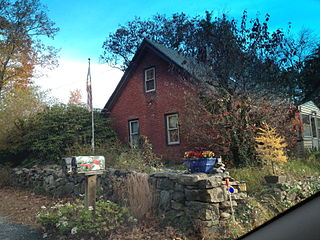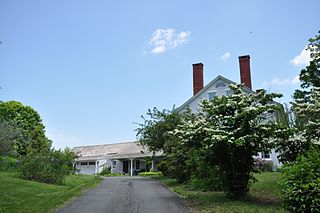
Boone Hall Plantation is a historic district located in Mount Pleasant, Charleston County, South Carolina, United States and listed on the National Register of Historic Places. The most important historic structures in the district are the brick slave cabins located along Slave Street which date between 1790 and 1810. The plantation is one of America's oldest plantations still in operation. It has continually produced agricultural crops for over 320 years and is open for public tours.

The Middletown Alms House is a historic building at 53 Warwick Street in Middletown, Connecticut, constructed in 1813–1814. It was originally used as a poorhouse and is the oldest surviving building built for housing the poor in Connecticut, as well as one of the oldest such in the United States. One of the largest structures of the Federal period in Middletown, it was listed on the National Register of Historic Places in 1982.

The Daniel Aldrich Cottage and Sawmill is a historic property at 364 Aldrich Street in Uxbridge, Massachusetts. It includes a c. 1830s late Federal style brick cottage, and at one time also included a rare surviving small-scale sawmill, built about 1835. They were built by Daniel Aldrich, member of a locally prominent family, were listed on the National Register of Historic Places in 1983.

New Market, as it was originally known, and later also known as Head HouseMarket and Second Street Market, is a historic street market on South 2nd Street between Pine and Lombard Streets in the Society Hill neighborhood of Philadelphia, Pennsylvania. With a history dating to 1745, it is one of the oldest surviving market buildings of its type in the nation. This portion, which survives from a longer structure originally extending all the way to South Street, was designated a National Historic Landmark in 1966, and is the centerpiece of the Head House Square historic district.

The Sugar Hill Historic District is a historic district in Detroit, Michigan. It contains 14 structures located along three streets: East Forest, Garfield, and East Canfield, between Woodward Avenue on the west and John R. on the east. The district was listed on the National Register of Historic Places in 2003.

The Maj. Joseph Griswold House, also sometimes referred to as the Mary Lyon House, is a historic house on Upper Street in Buckland, Massachusetts. Built in 1818, it is one of the region's finest examples of residential Federal period architecture. It is further notable for its association with pioneering women's educator Mary Lyon, who operated a school here before establishing Mount Holyoke College. The house was listed on the National Register of Historic Places in 1972.

The Washington Historic District in Washington, Kentucky was listed on the National Register of Historic Places in 1970, and its borders were increased in 1976. The buildings of Washington range from simple log cabins to late Georgian and early Federal styles constructed of home burned brick laid in Flemish Bond. Many houses have double doors at the entrance and a reeded roll length wise under a four light transom.

Phillips' Folly is an historic three-story brick residence in Maysville, Kentucky. The home's Antebellum architecture displays a blend of styles which may be explained, in part, by the home's speculative six-year construction period, which ended with its completion in 1831. The Sutton Street entrances are Federal, windows are typical Greek Revival in their size and character, and the two-tiered portico and the segmental dormers reflect a Georgian influence. The portico and Doric frieze are similar to Drayton Hall (1738–42) near Charleston, South Carolina. The stepped parapets on the end walls are peculiar to the Ohio River Valley and are "associated with the 'Dutch' character of Cincinnati, Ohio and the surrounding area." The home also possesses an artful and unique dry stacked foundation that is set without mortar.

The Courthouse Square and Mechanics' Row Historic District is a historic district in Maysville, Kentucky, USA. The district structures are situated on Third Street between Market and Sutton Streets.

The West Fourth Street District is an historic district in Maysville, Kentucky comprising five residences. The structures are situated on Fourth Street between Market and Sutton Streets. Construction is brick in the Greek Revival style with little exterior ornamentation. Parapets and stepped gables - reflecting the influence of German immigrants - are characteristic of river towns but unusual elsewhere in Kentucky.

The McLellan House is an historic house at 140 School Street in Gorham, Maine, USA. Built in 1773, it is the oldest known brick house in Cumberland County, and possibly the entire state. It is now part of the Gorham campus of the University of Southern Maine (USM), housing the Center for Education Policy, Applied Research, and Evaluation (CEPARE). It was listed on the National Register of Historic Places in 1972.

The Jonesborough Historic District is a historic district in Jonesborough, Tennessee, that was listed on the National Register of Historic Places as Jonesboro Historic District in 1969.

The Maysville Downtown Historic District or "downtown" is the area first settled and developed. Situated in the western part of Maysville, Kentucky, United States, the downtown is defined by a grid of streets laid out parallel to the northwest-southeast curve of the Ohio River. The area is essentially rectangular, four and a half blocks long and two to two and a half blocks wide. Its western edge is marked by Wall Street and its northern extent by West Front Street and McDonald Parkway. Its eastern and southern boundaries generally conform to the rear property lines of buildings on the east side of Limestone Street and the south side of Third Street respectively.

The Theophilus Crawford House is a historic house at 53 Hickory Ridge Road South in Putney, Vermont. Built about 1808, it is one of the oldest brick houses in Putney, and one of its finest examples of Federal architecture in brick. It was listed on the National Register of Historic Places in 1995. Its current owners operate it as the Hickory Ridge House Bed and Breakfast Inn.

Jackson Park Town Site Addition Brick Row is a group of three historic houses and two frame garages located on the west side of the 300 block of South Third Street in Lander, Wyoming. Two of the homes were built in 1917, and the third in 1919. The properties were added to the National Register of Historic Places on February 27, 2003.

Fifth Street Historic District is a national historic district located at Lynchburg, Virginia. The district encompasses 57 contributing buildings and 1 contributing object in a historically African-American section of Lynchburg. It includes a variety of residential, commercial, and institutional buildings, with about half dating to the period spanning from 1875 to 1940. Located in the district are the separately listed Kentucky Hotel, the Western Hotel, the William Phaup House, and the Pyramid Motors building. Other notable buildings include the Augustine Leftwich House, tobacco factories (1877-1885), the Humbles Building (1915), M.R. Scott Meat Market (1919), Miller Tire and Battery Company (1927), Adams Motor Company building (1927), Hoskins Pontiac (1951), Burnett Tire Company (1956), Moser Furniture Company building (1936), Fifth Street Baptist Church (1929), Community Funeral Home (1922), and Tal-Fred Apartments (1940).

The Boscawen Academy and Much-I-Do Hose House are a pair of historic civic buildings in Boscawen, New Hampshire. Now owned by the Boscawen Historical Society, these two buildings played a significant role in the civic history of the town for over 150 years, and were listed on the National Register of Historic Places in 1980.

The Phineas Heywood House is a historic house at 343 Maine Street in the center of Bucksport, Maine. Built c. 1824, it is one of the finest Federal style brick houses in the region, and was probably the first brick building erected in Bucksport and its surrounding towns. It was listed on the National Register of Historic Places in 1988.

Mount Pisgah Lutheran Church, also known in its early years as the First Lutheran Church and First English Lutheran Church and more recently as The Sanctuary on Penn, is located at 701 North Pennsylvania Street in downtown Indianapolis, Indiana. The historic church was built by the city's first Lutheran congregation, which organized in 1837, and was its third house of worship. The former church, whose present-day name is The Sanctuary on Penn, is operated as a for-profit event venue.























